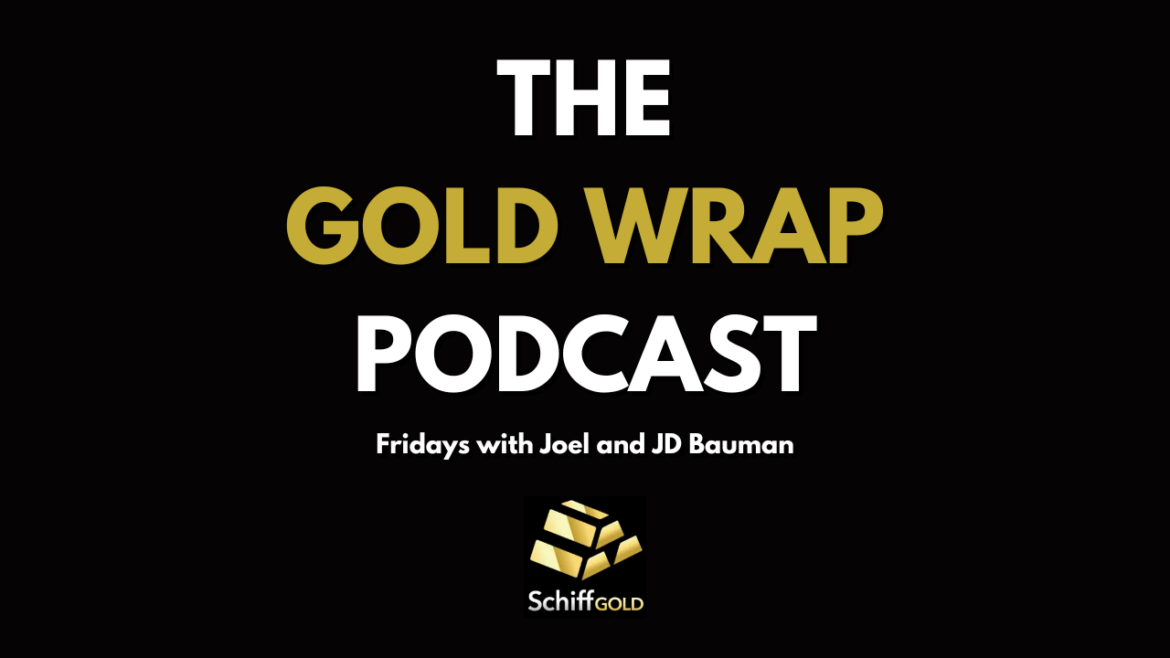Gold has all the potential to go unprecedentedly high. But silver will be gold on
Site:
Precious metals news
In this week's Friday Gold Wrap Podcast, JD and Joel discuss recent gold price action and market news. They also cover last Friday's non-farm payroll numbers, the strike on Houthi rebels, and the SEC's fumble with Bitcoin ETFs.
On Wednesday, January 11, the Securities and Exchange Commission (SEC) made an interesting decision, voting to allow everyday folks to participate in spot bitcoin ETFs. This move marks an opening for a broader audience to delve into Bitcoin speculation. The approved ETFs are set to be listed on various exchanges, including Nasdaq, the New York Stock Exchange, and the Chicago Board Options Exchange. This is supposed to provide an additional layer of oversight. But the announcement went terribly wrong, amplifying concerns about the ETFs.
In December, the U.S. federal deficit soared to $129 billion, marking a dramatic 52% increase from the previous year. This rise was fueled by a 3% hike in government expenditures, reaching a record $559 billion, primarily driven by escalated Social Security and public debt interest costs. Compounding the situation, December saw a 6% drop in government receipts to $429 billion, contrasted against the higher levels of December 2022, inflated by pandemic-delayed tax payments. Notably, the first quarter of the 2024 fiscal year witnessed the deficit climbing to $510 billion, a 21% rise from last year, with both outlays and receipts hitting record highs. The cost of interest on public debt also surged by 11% to $119 billion in December, attributed to elevated debt levels and a higher average interest rate of 3.11%, significantly up from the previous year.
Argentina’s inflation rate as hit annual rate of 3,678%. What can be done when the public loses faith in a currency?
The U.S. Labor Department reported a higher-than-anticipated rise in consumer prices for December, indicating persistent inflationary pressures in the economy. The consumer price index (CPI) saw a 0.3% increase in December, surpassing the 0.2% estimate expected by many economists and policymakers. This rise pushed the annual CPI rate for 2023 to 3.4%, exceeding the Dow Jones surveyed economists' forecast of 3.2%. This figure represents a notable decrease from the 6.4% annual CPI gain recorded in December 2022, yet suggests that inflation remains a concern.
A US government operation led by the Secret Service from 1865 covertly dismantled the gold and silver currency system.This strategic move, propelled by two acts of Congress, was a cunning ploy that centralized economic power.A commentator from the Mises Institute explores the little-known involvement of the Secret Service in this historical development, and how it impacted the very concept of US currency.
In a landmark decision, the U.S. Securities and Exchange Commission (SEC) has approved applications for spot price Bitcoin exchange-traded funds (ETFs) from 11 issuers, signaling a new era for cryptocurrency. Among the approved are applications from major financial players like BlackRock, Fidelity, and Franklin Templeton. Additionally, the SEC has authorized the digital asset manager Grayscale to convert its Bitcoin trust into a spot Bitcoin ETF. This approval is particularly significant for Grayscale, with a spokesperson confirming their readiness to uplist GBTC to NYSE Arca. Fidelity is also finalizing the registration process for its Bitcoin ETF, working in close coordination with the SEC. This decision by the SEC has been eagerly awaited and is seen as a major boost to the cryptocurrency market.
Jan 11, 2024 - 05:28:18 PST
Despite a rocky start for U.S. stocks in 2024 and a general bearish sentiment among Wall Street analysts, James Demmert, Chief Investment Officer at Main Street Research, offers a strikingly optimistic forecast. Demmert, overseeing a firm with $2 billion in assets, predicts a significant bull run for U.S. stocks in the next decade, fueled by the burgeoning artificial intelligence technology sector. He anticipates major U.S. equity indexes, including the S&P 500, Dow, and Nasdaq Composite, could double or even triple their value. "Similar to the 1990s, we are experiencing a transformational change in technology that is going to have far-reaching impact," the chief investment officer says...
 BEST & WORST PERFORMING SILVER MINERS: The Breakdown Of Gold & Silver Revenue Per Company & Trade Alert
BEST & WORST PERFORMING SILVER MINERS: The Breakdown Of Gold & Silver Revenue Per Company & Trade AlertJanuary 11, 2024
While investor sentiment in the mining shares has sunk to a LOW, one company has outperformed its competitors. What company am I talking about, and the group's worst-performing silver miner may be setting up for a short-term opportunity? Which one is it...
As 2024 unfolds, the financial markets face a new reality: the era of ultra-low, zero-percent interest rates is likely over. Investors, who initially believed the economy was deteriorating, adjusted their expectations towards the end of 2023, recognizing signs of improving economic conditions and a potential decrease in both inflation and interest rates. However, recent developments suggest that interest rates may not decline as significantly as hoped, given the stronger-than-expected economic performance. This change in perspective is causing some concern among investors.
Japan, once a dominant force in global gold importing during the 1980s and 1990s, has undergone a significant shift in its gold market dynamics. This change was initially influenced by the introduction of a consumption tax and further accelerated after the collapse of Japan's economic bubble in the 2000s. The country, which used to import gold extensively from various international sources, has now become a net exporter, primarily to Asia and London. This shift is exemplified by the author's experience at a Tokyo bank branch, where gold was mostly exported during their tenure. The evolving consumption tax, rising from 3% in 1989 to 10% in 2019, plays a complex role in this transformation. Although the tax is refunded upon selling gold, theoretically not impacting gold investment negatively, it has indirectly contributed to Japan's transition from a major gold importer to a net exporter.
Jan 10, 2024 - 08:56:03 PST
Morgan Stanley's recent analysis highlights a significant shift in how gold prices react to US interest rates and bond yields. Traditionally, gold prices have been influenced by the US dollar and inflation-adjusted bond yields, but this relationship notably weakened in the latter half of last year. Despite the decrease in US real yields, gold didn't gain as much as expected, partly due to escalating geopolitical tensions. Morgan Stanley analysts observed that gold's connection with real yields has evolved, displaying reduced sensitivity to yields while increasingly being perceived as a safe haven asset.
Join us as we explore the S&P 500 chart, dating back to 1925, and uncover potential trends and risks.
 Fed’s Barr Declares End to Emergency Loan Program Amid Banking Stability
Fed’s Barr Declares End to Emergency Loan Program Amid Banking StabilityJan 10, 2024 - 07:30:58 PST
Michael Barr, the Fed’s vice chair for supervision, announced that the Federal Reserve's Bank Term Funding Program, initiated during last year's regional banking crisis, will not be extended past its March 11 expiration. The program, designed as a temporary measure to alleviate financial system stress, allows banks and credit unions to borrow funds for up to a year. Despite a surge in borrowing due to anticipations of interest rate cuts, Barr emphasized its emergency nature and expects its usage to continue until the deadline. Barr also addressed questions about potential changes to capital requirements for major Wall Street banks and their impact on consumer credit and affordable mortgages.
This March, Republican primary voters in Texas won’t just be choosing which candidates to represent their party in November - they will also be voting on a series of ballot propositions that while not legally binding offer a way for voters to guide their leaders.Here’s why what is happening in Texas matters and what it says about the future of gold.
If history is a guide, the Stock Market is setting up for one heck of a Double-Top. We saw a similar Double-Top in the S&P 500 Index in 2007 before all hell broke loose. Is the market heading towards a similar fate? If we look at the increasingly lousy economic fundamentals... I say YES...
PIMCO, a leading U.S. bond manager, has issued a warning against early optimism over conquering inflation and recession. Despite market hopes for a smooth economic trajectory, PIMCO advises caution, emphasizing the continued risk of recession. They predict bonds may outshine stocks in 2024 if a recession hits, offering a safeguard against potential inflation spikes. However, they remain neutral on duration, a key metric for interest rate sensitivity, following a recent bond rally driven by expectations of Federal Reserve rate cuts. This cautious stance comes as U.S. Treasury yields have significantly dropped in recent months.
Silver is currently underpriced when considering the supply and demand dynamics for 2023. The Silver Institute's preliminary projections suggest a record industrial demand for silver, leading to a significant market deficit. At the Silver Industry Dinner in New York City, it was revealed that industrial silver demand is expected to surge by 8% to an unprecedented 632 million ounces. This increase is fueled by investments in photovoltaics, power grids, 5G networks, consumer electronics, and vehicle production. However, this industrial demand is contrasted by a projected 21% decline in physical investment demand for silver coins and bars, primarily due to reduced investment in India and Germany, influenced by high local prices and tax changes, respectively.
The World Bank's recent report paints a grim picture for the global economy, predicting the poorest half-decade growth in 30 years. Global growth is expected to slow down further in 2024 to 2.4%, marking the third consecutive year of deceleration. Although a slight increase to 2.7% is anticipated in 2025, this growth rate still falls significantly below the average of the 2010s. Geopolitical tensions, including the war in Eastern Europe and conflicts in the Middle East, are major contributing factors to this slowdown, potentially impacting energy prices, inflation, and overall economic growth. The World Bank warns of a "decade of wasted opportunity" without significant policy changes.
 Credit Card Debt Climbs: 56 Million Americans in Prolonged Debt Amid Economic Pressures
Credit Card Debt Climbs: 56 Million Americans in Prolonged Debt Amid Economic PressuresJan 9, 2024 - 07:33:53 PST
The credit card debt situation in the U.S. is becoming increasingly concerning, with a record $1.08 trillion in balances as reported by the Federal Reserve Bank of New York. Ted Rossman, a senior analyst at Bankrate, highlights a staggering 40% rise in credit card balances over the past two years. Notably, nearly half of all cardholders are now carrying their debt month-to-month, a significant increase from last year. This shift indicates growing financial strain, as 56 million Americans have been in credit card debt for over a year. Factors contributing to this trend include inflation, higher borrowing costs, and possibly shifts in lending practices. The Fed researchers suggest that this could be a sign of deeper economic distress.










